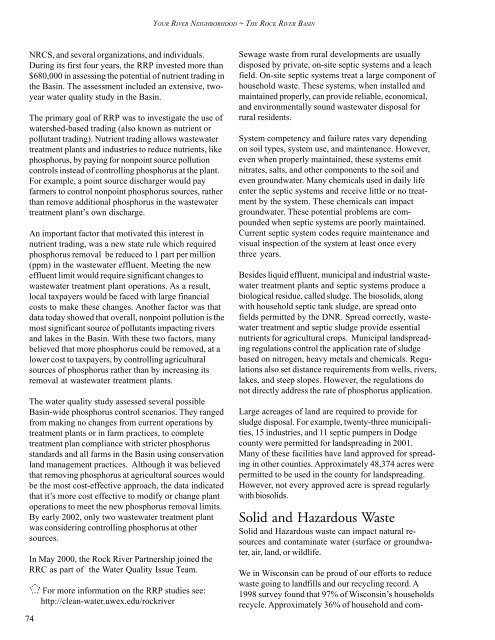Cities (PDF, 295KB) - Wisconsin Department of Natural Resources
Cities (PDF, 295KB) - Wisconsin Department of Natural Resources
Cities (PDF, 295KB) - Wisconsin Department of Natural Resources
Create successful ePaper yourself
Turn your PDF publications into a flip-book with our unique Google optimized e-Paper software.
YOUR RIVER NEIGHBORHOOD ~ THE ROCK RIVER BASIN<br />
NRCS, and several organizations, and individuals.<br />
During its first four years, the RRP invested more than<br />
$680,000 in assessing the potential <strong>of</strong> nutrient trading in<br />
the Basin. The assessment included an extensive, twoyear<br />
water quality study in the Basin.<br />
The primary goal <strong>of</strong> RRP was to investigate the use <strong>of</strong><br />
watershed-based trading (also known as nutrient or<br />
pollutant trading). Nutrient trading allows wastewater<br />
treatment plants and industries to reduce nutrients, like<br />
phosphorus, by paying for nonpoint source pollution<br />
controls instead <strong>of</strong> controlling phosphorus at the plant.<br />
For example, a point source discharger would pay<br />
farmers to control nonpoint phosphorus sources, rather<br />
than remove additional phosphorus in the wastewater<br />
treatment plant’s own discharge.<br />
An important factor that motivated this interest in<br />
nutrient trading, was a new state rule which required<br />
phosphorus removal be reduced to 1 part per million<br />
(ppm) in the wastewater effluent. Meeting the new<br />
effluent limit would require significant changes to<br />
wastewater treatment plant operations. As a result,<br />
local taxpayers would be faced with large financial<br />
costs to make these changes. Another factor was that<br />
data today showed that overall, nonpoint pollution is the<br />
most significant source <strong>of</strong> pollutants impacting rivers<br />
and lakes in the Basin. With these two factors, many<br />
believed that more phosphorus could be removed, at a<br />
lower cost to taxpayers, by controlling agricultural<br />
sources <strong>of</strong> phosphorus rather than by increasing its<br />
removal at wastewater treatment plants.<br />
The water quality study assessed several possible<br />
Basin-wide phosphorus control scenarios. They ranged<br />
from making no changes from current operations by<br />
treatment plants or in farm practices, to complete<br />
treatment plan compliance with stricter phosphorus<br />
standards and all farms in the Basin using conservation<br />
land management practices. Although it was believed<br />
that removing phosphorus at agricultural sources would<br />
be the most cost-effective approach, the data indicated<br />
that it’s more cost effective to modify or change plant<br />
operations to meet the new phosphorus removal limits.<br />
By early 2002, only two wastewater treatment plant<br />
was considering controlling phosphorus at other<br />
sources.<br />
In May 2000, the Rock River Partnership joined the<br />
RRC as part <strong>of</strong> the Water Quality Issue Team.<br />
74<br />
For more information on the RRP studies see:<br />
http://clean-water.uwex.edu/rockriver<br />
Sewage waste from rural developments are usually<br />
disposed by private, on-site septic systems and a leach<br />
field. On-site septic systems treat a large component <strong>of</strong><br />
household waste. These systems, when installed and<br />
maintained properly, can provide reliable, economical,<br />
and environmentally sound wastewater disposal for<br />
rural residents.<br />
System competency and failure rates vary depending<br />
on soil types, system use, and maintenance. However,<br />
even when properly maintained, these systems emit<br />
nitrates, salts, and other components to the soil and<br />
even groundwater. Many chemicals used in daily life<br />
enter the septic systems and receive little or no treatment<br />
by the system. These chemicals can impact<br />
groundwater. These potential problems are compounded<br />
when septic systems are poorly maintained.<br />
Current septic system codes require maintenance and<br />
visual inspection <strong>of</strong> the system at least once every<br />
three years.<br />
Besides liquid effluent, municipal and industrial wastewater<br />
treatment plants and septic systems produce a<br />
biological residue, called sludge. The biosolids, along<br />
with household septic tank sludge, are spread onto<br />
fields permitted by the DNR. Spread correctly, wastewater<br />
treatment and septic sludge provide essential<br />
nutrients for agricultural crops. Municipal landspreading<br />
regulations control the application rate <strong>of</strong> sludge<br />
based on nitrogen, heavy metals and chemicals. Regulations<br />
also set distance requirements from wells, rivers,<br />
lakes, and steep slopes. However, the regulations do<br />
not directly address the rate <strong>of</strong> phosphorus application.<br />
Large acreages <strong>of</strong> land are required to provide for<br />
sludge disposal. For example, twenty-three municipalities,<br />
15 industries, and 11 septic pumpers in Dodge<br />
county were permitted for landspreading in 2001.<br />
Many <strong>of</strong> these facilities have land approved for spreading<br />
in other counties. Approximately 48,374 acres were<br />
permitted to be used in the county for landspreading.<br />
However, not every approved acre is spread regularly<br />
with biosolids.<br />
Solid and Hazardous Waste<br />
Solid and Hazardous waste can impact natural resources<br />
and contaminate water (surface or groundwater,<br />
air, land, or wildlife.<br />
We in <strong>Wisconsin</strong> can be proud <strong>of</strong> our efforts to reduce<br />
waste going to landfills and our recycling record. A<br />
1998 survey found that 97% <strong>of</strong> <strong>Wisconsin</strong>’s households<br />
recycle. Approximately 36% <strong>of</strong> household and com-



![Nature program winter schedule [PDF] - Wisconsin DNR](https://img.yumpu.com/22471254/1/190x245/nature-program-winter-schedule-pdf-wisconsin-dnr.jpg?quality=85)
![City of Middleton [PDF] - Wisconsin Department of Natural Resources](https://img.yumpu.com/22300392/1/190x245/city-of-middleton-pdf-wisconsin-department-of-natural-resources.jpg?quality=85)

![Wetland Conservation Activities [PDF] - Wisconsin Department of ...](https://img.yumpu.com/21975633/1/190x245/wetland-conservation-activities-pdf-wisconsin-department-of-.jpg?quality=85)




![Baraboo River Region[PDF] - Wisconsin Department of Natural ...](https://img.yumpu.com/21975619/1/190x245/baraboo-river-regionpdf-wisconsin-department-of-natural-.jpg?quality=85)




